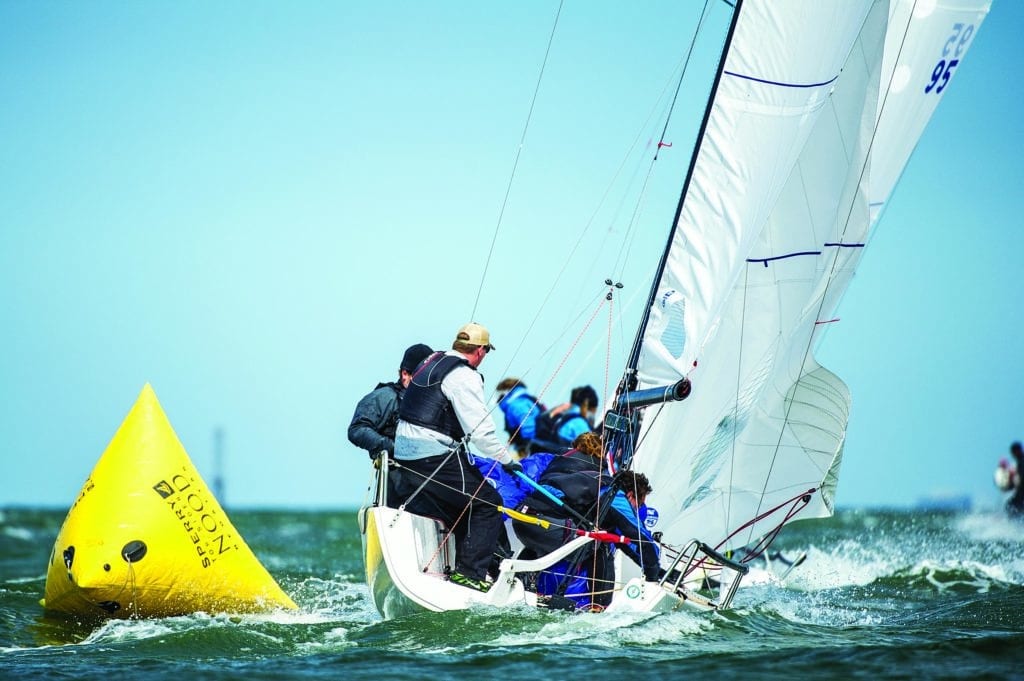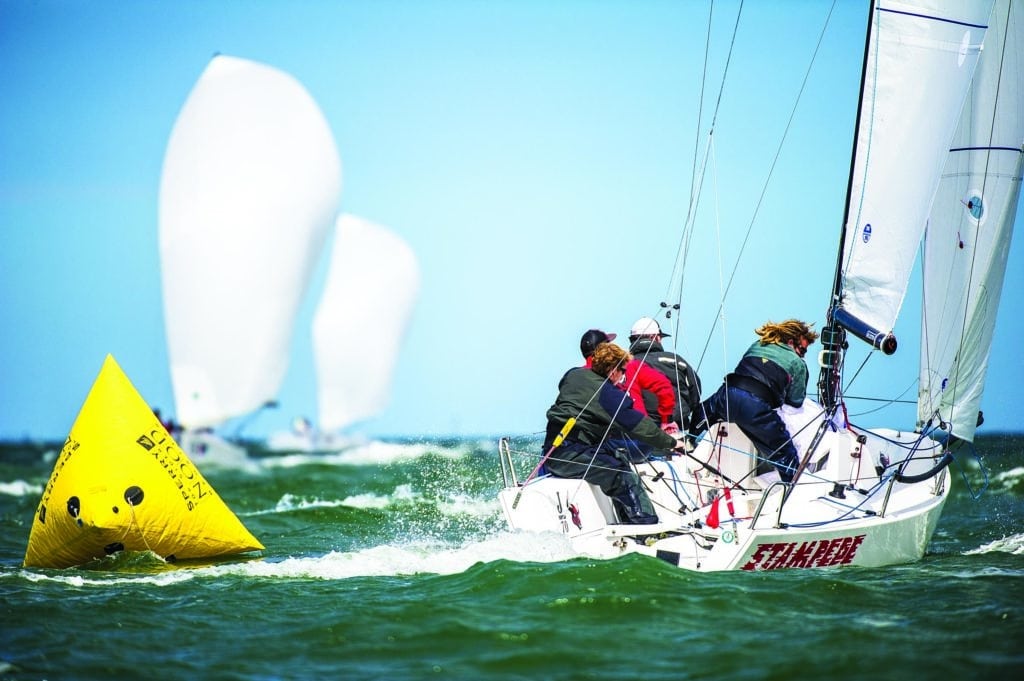
A smooth, efficient turn requires the input from the sails, hull, foils, and crew. Finding the right amount of each takes time and practice.
While coaching at the 2013 J/24 Worlds in Ireland, I watched a highly competitive fleet round the top mark, and then the gate marks at the bottom of the first lap. The lead group was tight, with the usual suspects among them, but there were also a few that were having the race of their lives—for the time being. One moment they were side by side with a top team. Then they’d lose a half boatlength while rounding a mark. With the next maneuver they’d lose another. And we all know what happens next: The top teams were able to get a clear lane and break free while the others faded into the fleet, never to recover. As I observed more, I could see how the best teams made each turn look effortless, much smoother and not just with rudder movement—they used all the tools available.
Let’s first look at how we turn the boat using the combination of rudder, sails, and heel. Fundamentally, the main and jib combination is like a windsurfer sail. On a windsurfer, leaning the mast aft shifts the sail’s center of effort (the center of the power in the sail) aft as well, which makes the board rotate into the wind. Similarly, trimming the mainsail increases leech tension and therefore increases leeward force aft in the boat, while easing the jib relieves force pushing the bow to leeward. When done in unison, the sail plan’s center of effort shifts aft relative to the center of resistance (the underwater foils), which makes the boat want to head up into the wind. Easing the main while trimming the jib does the opposite. Changing heel angle helps steer because of the shape of the hull. The roundness of the bow digging in to leeward while heeling makes the boat want to head up, and the bow digging in to windward (while flattening) makes the boat want to bear away. Steering with the helm is necessary and is by far the most reliable way of changing direction. We are not trying to eliminate using the rudder, we’re just trying to minimize its usage.
The right balance of helm, sails, and heel makes you smooth and fast. But how much of each should you use? There is no simple answer because it depends on the characteristics of your boat, the conditions, and how quick a turn needs to be. For example, if you have to do a big duck behind a boat, take the low lane out of a windward mark, or are executing a penalty turn, you might want to bear away hard. An aggressive bear away will require a substantial main ease and little—if any—jib ease while you heel to windward and pull the helm. While aggressively heading up around a leeward mark, at the start, or as part of a penalty turn, you will pull in your main as fast as you can while letting the jib luff, heeling to leeward, and actively pushing the helm.
Examining more closely such aggressive movements helps us understand the limits to the effectiveness of each method. Under-trimming either of the sails will cause them to luff. Over-trimming them will cause them to stall. Either way, the boat slows, and a slow boat doesn’t turn quickly. You can only vary from optimum trim so much before you will slow the turn. The limits are a partial luff and a slight over trim. Too much leeward heel will cause the boat to slip sideways and stall flow across the underwater foils, making it harder to steer. Change in heel angle of 5 to 10 degrees either way should be enough.

Too much helm either way (but particularly when bearing away) can act as a speed break. If it’s overdone, flow may even cease across the rudder and stop the turn completely. In short, if by using these techniques we lose too much flow on either our blades or sails we’ve gone past the productive limits. A maneuver that requires a quick turn will push the limits of losing flow. A maneuver requiring a small turn will only vary subtly from optimum speed.
Each unique boat will require its ideal combination of helm, heel, and trim. For example, if your boat has a small rudder, it will lose flow easily on the rudder so you want to minimize helm use and focus your efforts on using sails and heel to turn the boat. If your boat has a small main, it will lose flow easily, so more rudder and heel than sails may be best. If your boat has a small or inefficient keel, it will slide sideways easily, so don’t overdo it with the heel. If your boat has a large genoa, make sure you only vary slightly from optimum trim because it’s so important to the speed of your boat. If you over trim it too much, it will act as a break, and if you under trim it too much, you will lose a good portion of your speed force and that’s not good either. If your boat is lightweight, say a dinghy, much of a turn can be done with body weight. My Thistle, for example, has a large main and large rudder, but a small jib. I can steer well with weight, and I really focus on using the main because it is so much bigger than the jib. The rudder is much smaller on the Thistle, so we try to use it as little as possible. Conversely, a J/24 is a lot heavier so we still try to steer with heel, and since it has such a large genoa, we make sure that it’s trimmed well.
Armed with these basics, the only way to know what works best for your boat is to experiment with these characteristics. To start with, I recommend leaving complications ashore, such as extra crew and the spinnaker gear. You want to focus on the pure maneuvers without those distractions—they will be easy to add later. Next, experiment with turning too fast, trimming too hard, and heeling too much so you understand the limits of your boat. Then record some video as you experiment. For example, try a leeward mark rounding three ways: exaggerating the sail trim in one, the heel in the next, and finally the rudder. Then try subtle combinations.
Don’t underestimate the of value of helm feedback. You will know you have it right when you do your move with the helm feeling smooth and unforced. You should be able to immediately feel in your fingertips any unbalance in trim or heel. Then, watch check out your wake: If leaving a question-mark trail, you need to rebalance. If your leeward mark rounding shows a lot of turbulence, and your track indicates you’re sliding sideways, you’ve heeled too much.
Once you understand the right combinations for each move on your boat, you can add the rest of the team. Practice it so everyone knows what to do without much micromanaging; there is no time for that. Someone, usually the helmsman, will need to modify what is happening. For example, if you feel too much force one way or the other on the helm, recognize it quickly and call for a modification such as “less heel,” or “ease the jib.”
There are many factors that lead to sailboat racing success, but I find in my coaching that people tend to put the mechanics of turning as a low priority. They will work so hard to gain one boatlength upwind just to lose it at the corners. A small investment in learning your boat, then practicing to optimize your turns puts you in control of your race and that, for sure, is much more fun.









